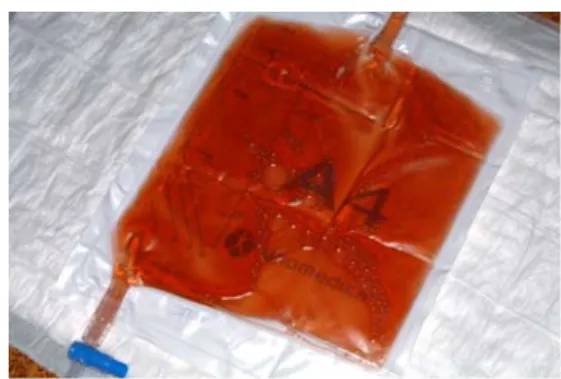LETTER TO THE EDITOR
Abdominal pain in a patient with acute
lymphoblastic leukaemia
Alexander Breitenstein&Reto Kühne&
Elisabeth I. Minder&Aleksandra Marek&
Jeroen Goede&Urs Schanz&Christoph Renner
Received: 24 June 2009 / Accepted: 26 June 2009 / Published online: 9 July 2009
# Springer-Verlag 2009
Dear Editor,
A 57-year-old man was admitted to our hospital with acute lower abdominal pain and diarrhoea. The patient had been diagnosed with a CD20 and bcr-abl positive B-cell acute lymphoblastic leukaemia 15 months ago and was treated with four cycles rituximab-Hyper-CVAD. He was healthy with a complete molecular remission at his last routine examination 4 weeks ago.
A CT scan of the abdomen revealed colitis of the colon descendens with perifocal oedema. Antibacterial therapy with piperazillin/tazobactam was initiated resulting in a normalisation of the initially elevated inflammatory blood markers. In contrast, the abdominal pain worsened although the analgesic therapy was substantially intensified. Due to increased pain, the patient’s oral food intake was poor. Additionally, he developed tachycardia, hypertension as well as episodes with aggressiveness and loss of orienta-tion. Further investigations, including extensive blood and bacterial stool analysis as well as a gastro- and colono-scopy, were unremarkable except for the urine, which turned from a clear yellow to a dark red colour (Fig. 1),
highly suggestive for an acute porphyria. Indeed, increased levels of δ-aminolevulinic acid and porphobilinogen were found in the urine. All porphyrinogenic drugs were halted, an adequate caloric intake was guaranteed by nasogastric feeding and the patient was treated with exogenous heme-arginate for 4 days. The patient recovered completely from his symptoms within a few days and was discharged after 2 weeks of hospitalisation. A molecular analysis was positive for the presence of the W283X-mutation in the porphobilinogen deaminase gene, a common mutation in Swiss residents with acute intermittent porphyria (AIP). He was completely asymptomatic when last seen in April 2009. AIP is an autosomal-dominant inherited disease of the heme biosynthetic pathway with a prevalence of symptom-atic disease of one to two per 100,000 [1]. In AIP, the activity of the porphobilinogen deaminase (PBG) is reduced, resulting in an accumulation of upstream porphy-rin precursors δ-aminolevulinic acid and porphobilinogen. At the moment, over 250 mutations in the PBG gene are known. Nearly 60% of all Swiss patients with an AIP carry the nonsense mutation W283X [2]. The majority of the mutation carriers are clinically healthy and exhibit symp-toms only in situations when precipitating factors are present [3]. These include various drugs, poor energy intake during fasting as well as stress from illness and fever. Under these circumstances, the heme biosynthetic pathway gets activated and results in an excess accumula-tion of the porphyrin precursors δ-aminolevulinic acid and porphobilinogen due to the PGB enzyme deficiency. The key issues for acute therapy are to avoid drugs known to be porphyrinogenic, to promptly treat infections and to maintain an adequate caloric intake. Furthermore, intrave-nous heme derivates supporting the increased heme demand are the most effective treatment modalities for acute porphyria attacks [4].
A. Breitenstein (*)
Department of Internal Medicine, University Hospital Zurich, Rämistrasse 100,
8091 Zurich, Switzerland
e-mail: alexander.breitenstein@usz.ch
R. Kühne
:
A. Marek:
J. Goede:
U. Schanz:
C. Renner Hematology Department, University Hospital Zurich, Zurich, SwitzerlandE. I. Minder
Zentrallabor, Stadtspital Triemli, Zurich, Switzerland
Ann Hematol (2010) 89:211–212 DOI 10.1007/s00277-009-0789-4
It is interesting to realise that this patient was treated by an intensive chemotherapy regimen without the develop-ment of any symptoms. Currently, he is under maintenance treatment with dasatinib, a novel bcr-abl tyrosine kinase inhibitor, from which it is not yet known if it is tolerated by patients with acute porphyria.
Acknowledgements This case report was not supported by any funding source. The authors report no conflicts of interest. All authors contributed equally to this work.
References
1. Badminton MN, Elder GH (2002) Management of acute and cutaneous porphyrias. Int J Clin Pract 56:272–278
2. Schneider-Yin X, Bogard C, Rufenacht UB, Puy H, Nordmann Y, Minder EI, Deybach J (2000) Identification of a prevalent nonsense mutation (W283X) and two novel mutations in the porphobilinogen deaminase gene of Swiss patients with acute intermittent porphyria. Hum Hered 50:247–250
3. Anderson KE, Bloomer JR, Bonkovsky HL, Kushner JP, Pierach CA, Pimstone NR, Desnick RJ (2005) Recommendations for the diagnosis and treatment of the acute porphyrias. Ann Intern Med 142:439–450
4. Bonkovsky HL, Healey JF, Lourie AN, Gerron GG (1991) Intravenous heme-albumin in acute intermittent porphyria: evi-dence for repletion of hepatic hemoproteins and regulatory heme pools. Am J Gastroenterol 86:1050–1056
Fig. 1 The patient’s red urine during the acute attack
